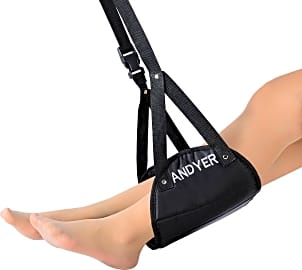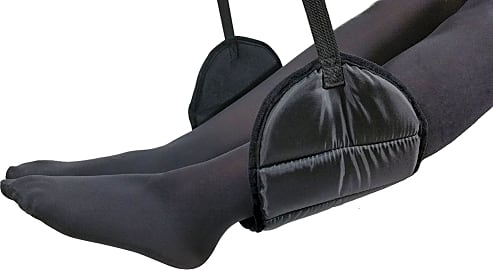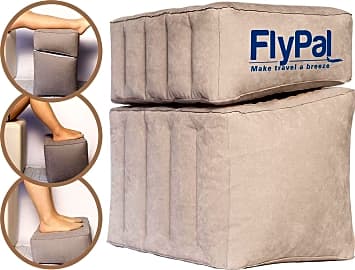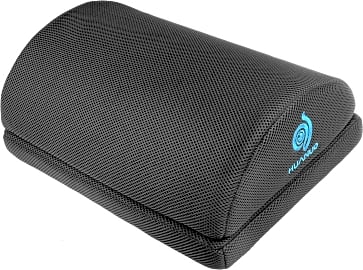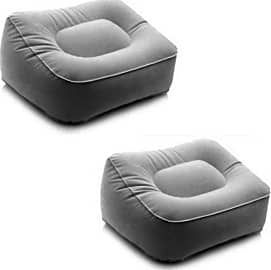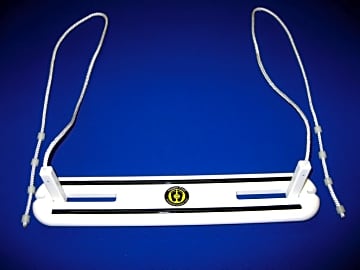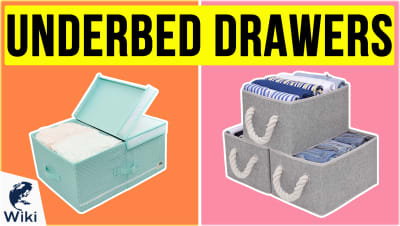The 10 Best Airplane Footrests

This wiki has been updated 29 times since it was first published in March of 2018. Comfort can be hard to come by in the close confines of an airplane cabin, especially if your feet don't reach the ground. There is a risk of joint pain and deep vein thrombosis, which could derail your business trip or family vacation. But if you take your own footrest, you'll be able to nap and enjoy a better posture, even in a cramped seat. You can use many of them on train and in cars, too. When users buy our independently chosen editorial choices, we may earn commissions to help fund the Wiki.
Editor's Notes
December 03, 2020:
Airplane footrests can be a great way to make a plane ride more comfortable for yourself or your child, however it is important to understand who these are good for and have realistic expectations of what they offer. They aren't going to magically make that tight economy seat feel like a luxurious recliner. Also, generally speaking, if your feet already easily reach the floor when in the airplane seat, you probably won't get much benefit from any of these. That being said, if they dangle or only barely touch the floor, both of which can result in a lot of pressure and discomfort on the backs of the legs as well as hindering circulation, they can be a great accessory to take along on your travels.
For most short adults, we think the sling options, such as the Eveur Custom 1047, Andyer d076, Sleepy Ride SRMFFR, and Facelink CSL-100, are going to be the best choice. They offer convenient and compact portability, have easily-adjustable heights, and provide the feet with a soft place to rest. The Eveur Custom 1047 and Sleepy Ride SRMFFR, both of which feature plush memory foam, certainly exhibit this last property. The Eveur Custom 1047 also boasts a small pillow that separates your feet to keep them in an ergonomic position. That being said, we do realize the some may find hanging them to be a hassle, so, if you think you might fall into this group, you are probably better off with the Econo High Portable. You should be aware though that this is just a hard plastic stool and offers no cushioning.
When it comes to very young kids, we recommend looking at inflatables models, like the Flypal Blow-Up and Prazoli Koala Kloud. These are large enough to completely fill the gap between your child's seat and the one in front of them, essentially turning it into a small bed they can spread out on. Of course, these aren't completely useless for adults, as the Flypal Blow-Up is comprised of two cushions, the smaller of which might be just the right height for some. Likewise, the Prazoli Koala Kloud, while only consisting of a single large cushion, can be inflated to your desired height and then you can use the included drawstring dust cover to keep it at the right pressure.
June 27, 2019:
At this time, the EazyFeet Pink has become difficult to find, so we removed it, even though we liked its styling. But as for other hammock types, we still think the Andyer Carry-on, the Sleepy Ride, and the Facelink Feet Hammock are fine choices. The Andyer is the least padded of these, so if you have sensitivity issues, you might find it tough to use for long periods. There's also the Phelrena New-Type, which gives you two separate compartments, one for each foot, that will keep your feet and legs from rolling in and squishing together. This also makes it a little tougher to get into and out of, though, so if you have mobility problems, it may not suit.
As for inflatables, it remains hard to beat the Homca Adjustable, especially if you have young travelers with you who could use a proper place to lie down. The only problem is that it is not allowed by all airlines, because it can interfere with safety equipment and procedures. This goes for all larger footrests, so you may wish to inquire in advance whether your footrest is allowed by the airline you'll be flying.
The Rest You Deserve
It offers foot support that puts you closer to a reclining position, taking much of the struggle out of getting some inflight shuteye.
There are probably two or three people on this planet — five at most — who enjoy sleeping sitting up, but for the rest of us, the airplane footrest is a lifesaver. It offers foot support that puts you closer to a reclining position, taking much of the struggle out of getting some inflight shuteye. That's probably reason enough to take one along on your next journey, but these handy travel tools might even be good for your health.
Cramped seats, inactivity, and dry air contribute to flyers' risk of developing deep vein thrombosis, a type of blood clot that can lead to serious health problems. Keeping your legs crossed and letting the seat push into the backs of your legs for extended periods may also heighten your risk, but an airplane footrest can help get you out of these positions. By keeping your legs extended, you'll have increased blood flow, which is key to decreasing the risk of blood clots. Pair this with some compression socks, and you should have very little to worry about (unless you have certain risk factors, in which case you should consult your doctor).
Of course, a footrest is one more thing to pack, so you might wonder why you can't just prop your feet on your carry-on. You certainly can, but you risk squashing everything inside, and besides — your feet have been all over the airport, probably the airport bathroom, too (shudder). Do you really want to put them all over your bag, which you'll then carry on your back or against your body in some fashion? Stash your bag in the overhead bin and let an airplane footrest take the abuse from your (probably dirty) feet.
Suspend Or Inflate?
Airplane footrests come in two main types: inflatable, which you blow up, and suspended, a hammock for your tootsies. Neither is inherently better than the other, but there are a few benefits and drawbacks to each.
Inflatables are great for those who need more room, because they tend to provide a larger surface area. For those with kids, this can be a boon; if the footrest is tall enough, it extends the seat and gives little ones more room to lie flat. And if you don't have kids, you can still appreciate the space, which lets you spread out your feet and relax.
Foot hammocks won't pop or leak, and there's no big or bulky item to move out of the way if someone needs to get by.
On the other hand, you'll have to blow it up and deflate it. If you're sensitive to people looking at you, well, this could be uncomfortable. Plus, inflatables are less durable in general, as one tiny hole and the item is rendered useless, at least until you can repair it. You'll need to be gentle with an inflatable, then, and perhaps carry a patch kit.
Foot hammocks won't pop or leak, and there's no big or bulky item to move out of the way if someone needs to get by. They aren't as noticeable, either, so you won't make a public spectacle of yourself just to get some rest. And if you want to change the angle at which your legs are resting, you can do so with simple adjustments.
But a hammock does have a few small drawbacks. For one, you'll need somewhere to hang it. If you're in a bulkhead seat, that could be a problem. In most other seats, you can suspend the hammock from the tray table or the seat in front of you, but be cautious not to jostle the person who occupies this seat — unless you don't mind dirty looks. Finally, a hammock has the tendency to roll your feet together, so you can't spread out quite as much as you can with an inflatable.
Since both options have positives and potential negatives, the choice comes down to personality and situation. Generally, though, people who want to spread out in the bulkhead and those who have kids might go with an inflatable; fliers who want to keep a low profile and rest their feet and legs at different angles should consider a hammock.
Tips For A Stress-Free Plane Ride
Whether you're riding in first class or in the back with the cattle, there's a lot you can do to make your flight more pleasant. At the very top of this list? Investing in the right gear, those items that let you manage your personal space and bodily comfort. At minimum, these include earplugs, an eye mask, a pillow, a blanket (for long haul flights), and some high-quality lip balm and moisturizer. Headphones and portable battery chargers are popular choices, as well.
Whether you're riding in first class or in the back with the cattle, there's a lot you can do to make your flight more pleasant.
But don't get too comfortable — avoid big meals and excess snacking, which can contribute to jet bloat. Caused by the changes in atmospheric pressure you're subjected to in flight, this digestive distress can make it hard to relax and sleep. A big, heavy meal can aggravate this feeling, as can carbonated beverages. If you're especially prone to bloating and gas while flying, skip any high-FODMAP foods the day of your journey, such as wheat, some artificial sweeteners, and many fruits.
We're sorry to say that alcohol is another contributor to an uncomfortable plane ride, one that can increase bloating, dehydrate you, and cause you to sleep poorly. True, you might fall asleep more quickly after knocking back a few cocktails, but you won't rest as well as you would without the alcohol in your system. Save the partying for your destination.
Finally, one of the best ways to arrive feeling refreshed is to drink plenty of water. This can be tough, as many airlines have stopped providing free water and you are no longer able to bring liquids through security. But you should be allowed to bring an empty bottle airside, which comes in handy at airports with drinking fountains or water bottle filling stations. Before you leave, check out the websites for the airports you'll be flying through, because they often note whether there is free water and, if so, where.


